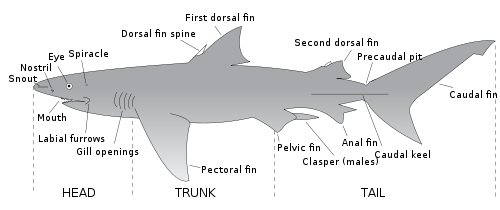Shark anatomy

Shark anatomy has points of difference with the anatomy of bony and other types of fish. The large number of species and the diversity of shark habitats means that there are also variations on the "typical" shark's bodies.
Skeleton
The skeleton of a shark is mainly made of cartilage.
Fins

Most sharks have six fins: a pair of pectoral fins, a pair of pelvic fins, two dorsal fins, an anal fin, and a caudal fin. The members of the order Hexanchiformes have only a single dorsal fin. The anal fin is absent in the orders Hexanchiformes, Squaliformes, Squatiniformes, and Pristiophoriformes. Shark fins are supported by internal rays called ceratotrichia.
Tail
The tail of a shark consists of the caudal peduncle and the caudal fin, which provide the main source of thrust for the shark. Most sharks have heterocercal caudal fins, meaning that the backbone extends into the (usually longer) upper lobe. The shape of the caudal fin reflects the shark's lifestyle, and can be broadly divided into five categories:
- Fast-swimming sharks of open waters, such as the mackerel sharks, have crescent-shaped tails with upper and lower lobes of almost equal size. The high aspect ratio of the tail serves to enhance swimming power and efficiency. In these species, there are usually also lateral keels on the caudal peduncle. The whale shark and basking shark also have this type of tail, although they are generally more sedate animals than the other examples.
- "Typical sharks", such as requiem sharks, have tails with the upper lobe longer than the lower. The upper lobe is turned upwards at a moderate angle relative to the body, which balances cruising efficiency with turning ability. The thresher sharks have an extreme example of this tail in which the upper lobe has evolved into a weapon for stunning prey.
- Bottom-dwelling sharks such as catsharks and carpet sharks have tails with long upper lobes and virtually no lower lobe. The upper lobe is held at a very low angle, which sacrifices speed for maneuverability. These sharks generally swim with eel-like undulations.
- Dogfish sharks also have tails with longer upper than lower lobes. However, the backbone runs through the upper lobe at a lower angle than the lobe itself, reducing the amount of downward thrust produced. Their tails cannot sustain high speeds, but combine the capability for bursts of speed with maneuverability.
- Angel sharks have unique tails among sharks. Their caudal fins are reverse heterocercal, with the lower lobe larger than the upper.[1]
Integument
Unlike bony fish, the sharks have a complex dermal corset made of flexible collagenous fibres and arranged as a helical network surrounding their body. This works as an outer skeleton, providing attachment for their swimming muscles and thus saving energy. A similar arrangement of collagen fibres has been discovered in dolphins and squid. Their dermal teeth give them hydrodynamic advantages as they reduce turbulence while swimming.
Circulatory system

Like higher up vertebrates, sharks have a four chambered heart. Unlike other vertebrates, sharks have a single-circuit circulatory system, blood flows from the heart, to the gills where it is oxygenated, throughout the body where it is deoxygenated and then back to the heart to repeat. The flow of the heart in order is: sinus venosus, atrium, ventricle and conus arteriosus. [2]
Respiratory system
Like other fishes, sharks extract oxygen from water as it passes over their gills. The water enters through the mouth, passes into the pharynx, and exits through the gill slits (most sharks have five pairs, the frilled sharks, cow sharks, and sixgill sawshark have six or seven pairs). Most sharks also have an accessory respiratory opening called a spiracle behind their eyes. In bottom-dwelling sharks such as angel sharks, the spiracle allows them to take in water to breathe without having to open their mouths .
There are two mechanisms that sharks can use to move water over their gills: in buccal pumping, the shark actively pulls in water using its buccal muscles, while in ram ventilation, the shark swims forward, forcing water into its mouth and through its gills. As buccal pumping is more energy-intensive than ram ventilation, the former is generally used by sedentary, bottom-dwelling sharks while the latter is used by more active sharks. Most sharks can switch between these mechanisms as the situation requires. A few species, such as the great white shark, have lost the ability to perform buccal pumping and thus will suffocate if they stop moving forward.[3]
See also
References
- ↑ Thomson, K.S.; Simanek, D.E. (1977). "Body form and locomotion in sharks". American Zoologist. 17 (2): 343–354. doi:10.1093/icb/17.2.343.
- ↑ Kardong, K. Zalisko, E. (2006). Comparative Vertebrate Anatomy: A laboratory disection guide. New York, NY: McGraw-Hill Companies.
- ↑ Edmonds, M. "Will a shark drown if it stops moving?". HowStuffWorks. Retrieved April 28, 2013.
